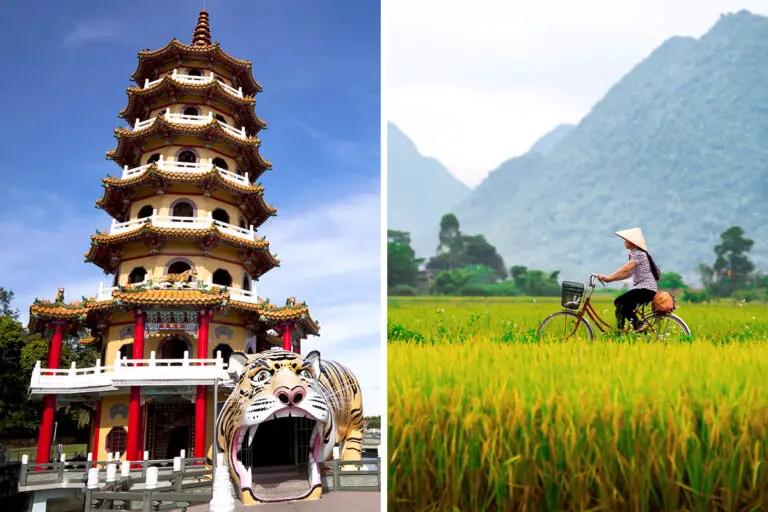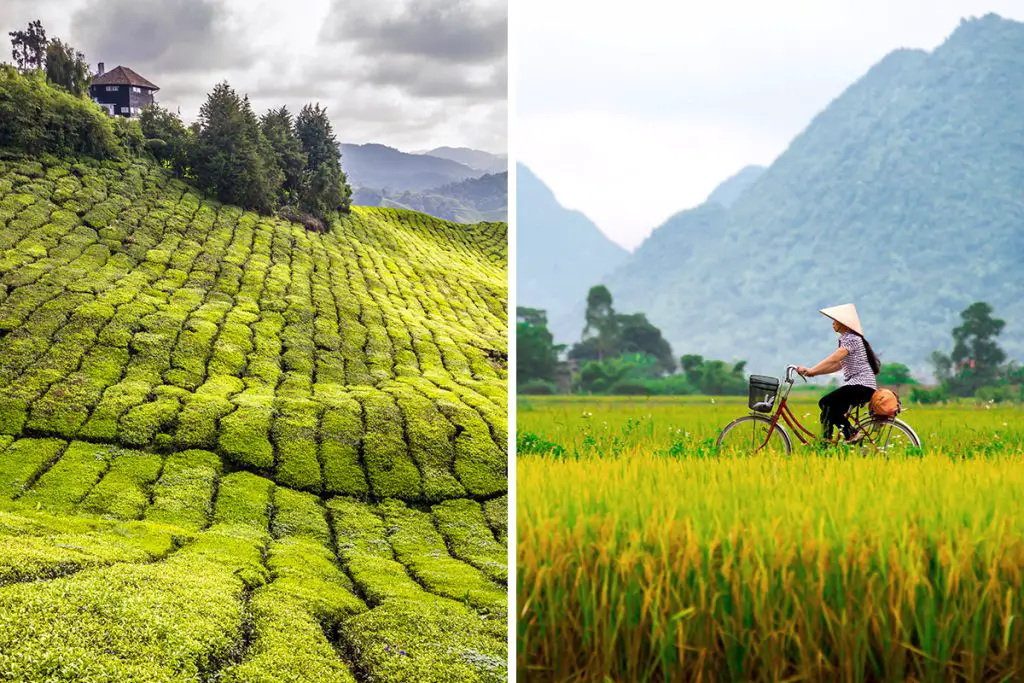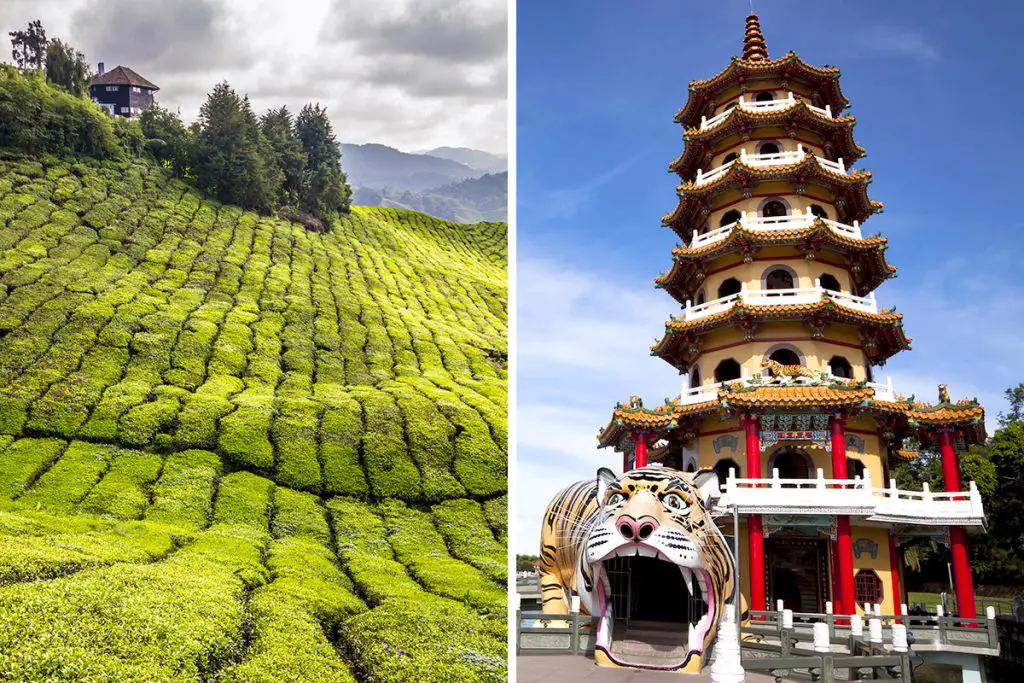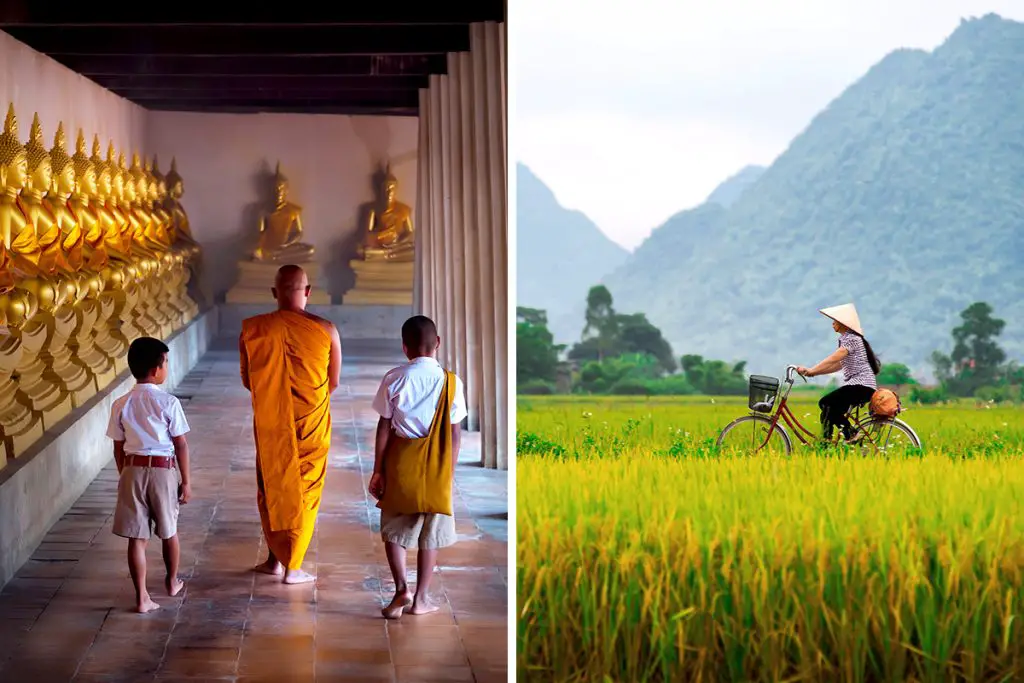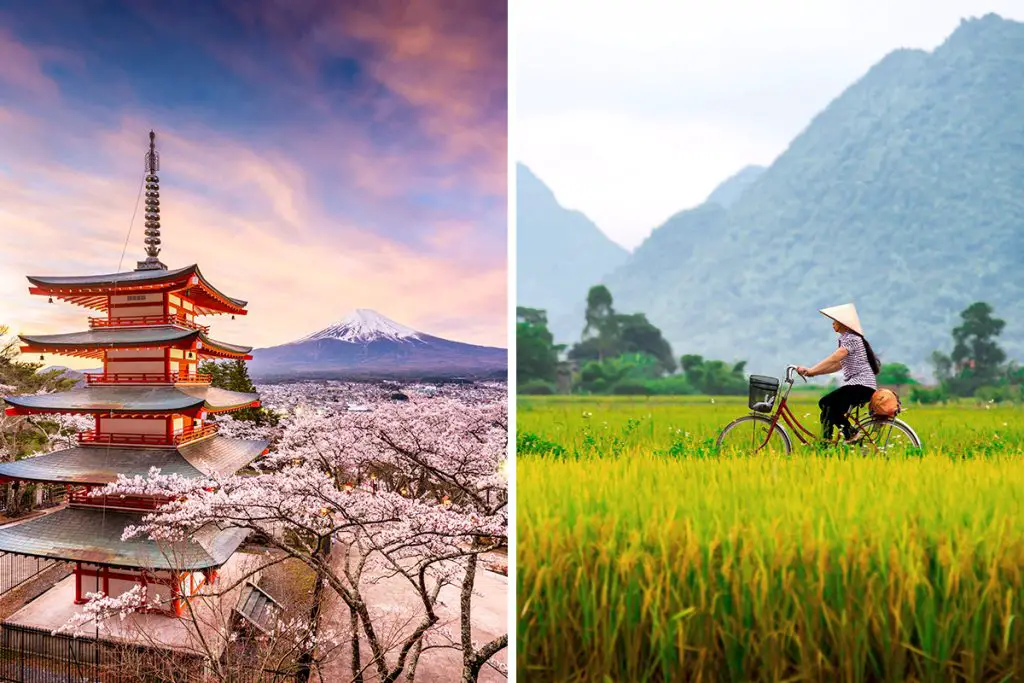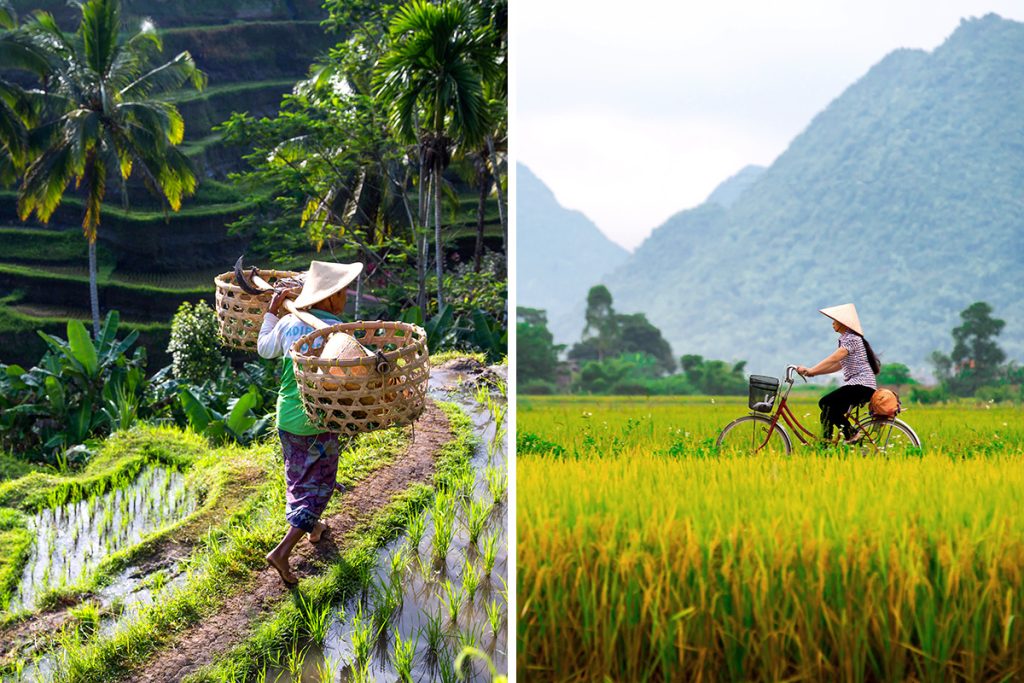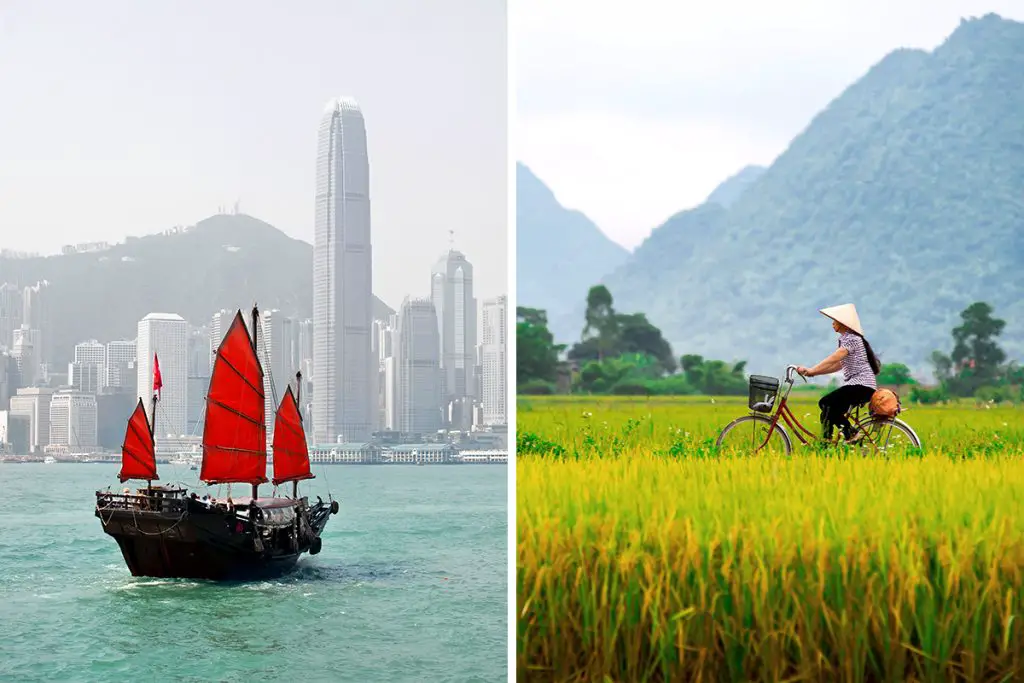Taiwan may be small, but it offers quite the most intriguing culture and a diverse set of draws in the South China Sea area. It is also the most thriving economy in the region. Vietnam offers a diverse and beautiful landscape and arguably the best dishes in all of Southeast Asia.
Taiwan
Taiwan, an island nation in East Asia, may seem small, but it has a huge variety of attractions. Taiwan is undoubtedly one of the most well-liked tourist destinations in Asia, particularly for foodies. Can one even quickly respond to the question: “What is Taiwan renowned for?”
Taiwan is a place where you can take in its natural beauty, discover historical influences, and be amazed by modern innovation. Although it has absorbed the impacts of its neighboring nations, its culture and architecture have also inspired others.
Despite its modesty, the kind attitude and inventiveness of its people have allowed it to develop a rich culture. They have even built amazing monuments and produced cuisines that are now known all over the world.
What Makes Taiwan Unique?
Taiwanese Food
Taiwan may be a small country, but it is big on gastronomy. With a palate of a wide variety, from street food to bounties of the sea, Taiwan is yet another one of Asia’s food capitals. The island nation is the birthplace of much famous food that is now enjoyed across different corners of the globe. Here are some of their pioneering dishes and the most famous:
The Famous Bubble Tea
Tea lovers from all over the world go to Taiwan each year to sample some of the island’s greatest tea. Taiwan produces some of the most sought-after teas in the world. Tea boxes across the island nation are some of the most popular souvenirs on the market, and there are teashops all over the place.
However, The most well-known drink from Taiwan is probably bubble tea, also known as boba. The very popular and adored boba is simply a sweet treat made with milk tea and filled with pearl-shaped tapioca balls.
This relatively new beverage, which was created, in the 1980s is quickly becoming a global favorite, and it all began right here in Taiwan. Funny how the rest of the world only recently “found” it.
Beef Noodles
The greatest way to experience Taiwan’s culinary tradition is with a bowl of beef noodle soup. Beef noodle soup is the most popular food in Taiwan and is frequently referred to as the country’s dish. It can be found anywhere, from food courts to high-end restaurants. It is the most well-known cuisine in the area, and no two bowls are the same.
No matter where you eat, the taste and quality of this meal should be very excellent. There is tremendous competition to make the tastiest bowl. The most popular and traditional kind is braised beef simmered in a very flavorful, hot broth.
Also highly popular are tomato-based and clear broth. However, every city and eatery has its unique interpretation of this revered dish. Be prepared to encounter intriguing tastes like creamy satay and curry.
Stinky Tofu
The most controversial dish in Taiwan may very well be stinky tofu. In contrast to those who detest it (mostly due to its offensive odor), people who adore stinky tofu can’t seem to get enough of it. Stinky tofu is a very popular street snack in Taiwan, believe it or not.
It’s the fermentation that gives the infamous dish its funky smell. For weeks to months, fresh tofu is steeped in a brine made of fermented milk, pork, or vegetables (or a combination of all three). The fermented tofu is then divided into small cubes and deep-fried till crisp and golden in color. Pickled veggies and soy-chili sauce are typically provided on the side.
Night Markets
If you’re one for street food and the local life, night markets are the best experience you can have. Luckily, just like many Asian cultures, Taiwan is big on night markets as well. Here you can sample the most authentic pieces of Taiwan’s culture.
Even while there are night markets all around Asia, none compare to those in Taiwan. They are vibrant centers of activity in this place, and they may be found in almost every neighborhood. The Taiwanese night market includes everything and more in terms of food, clothing, strangely shaped cakes, toys, and games.
Night markets are popular among locals as well as tourists looking for fast meals and inexpensive eats. There are innumerable numbers all around the nation. According to an unconfirmed assessment, there are around 400—roughly one in every neighborhood!
Every night market is distinct and has its own features. While some serve inventive creations like deep-fried yam balls and ramen burgers. Others serve more conventional Taiwanese delicacies. You can check out braised-pork rice and oyster omelets.
Shilin Night Market, Taiwan’s largest night market, is frequently at the top of travelers’ lists. There, among the 500 or so stalls, you may find a huge variety of delectable foods, entertaining carnival games, and a lot of unique souvenirs.
The three most well-known night markets in Taipei are Raohe Street, Shilin, and Shida. Visit Taichung’s Fengjia Night Market if you want to try something novel.
LGBTQ+ Acceptance
The people of Taiwan are welcoming to visitors. Period. It is irrelevant what language you speak, what color your skin is, or how you identify. You are you whether you are straight, gay, bisexual, or transgender. Expect that the warm people of Taiwan will extend a friendly greeting to you.
It is so LGBT-friendly that it recently passed the same-sex marriage bill. The island nation is the first Asian country to do so, making it the most progressive country in terms of human rights development. Additionally, Taiwan hosts the biggest LGBT pride parade in Asia every autumn, drawing tens of thousands of visitors from all across the island and its neighbors!
LGTB visitors don’t need to be concerned about being themselves. They can even display their affection to their significant other in public in such a progressive society.
The famous Red House Theatre is located across the street from the busy Ximending neighborhood. It is a historic establishment that frequently serves as a stage for plays and musical acts. It is often regarded as the unofficial LGBTQ+ district of Taipei. You can find a lot of gay clubs and entertainment venues just beyond the area.
Taipei
Is the capital of Taiwan and therefore its defacto tourist capital as well. While many globetrotters will go over Taipei when they gallivant across Asia, the capital is a treasure trove in itself. This bustling city provides an intoxicating blend of culture and relaxation. It has hot springs and mountain trails nearby for day trips.
The best first step to acquaint yourself with the city is, of course, through food. In Taiwan, you may get nearly every type of Asian cuisine, including delicious Japanese food and local Chinese cuisine. Japan, after all, colonized Taiwan for 50 years until 1945.
Taiwanese people like eating and Taipei’s streets are crowded with many palates. You can find eateries, food carts, and, in many locations, lively night markets. At least one night market each night should be visited by every traveler. The best ones are Ningxia, Raohe, and Shilin.
After satisfying your palates, dedicate your itinerary to the acquaintance of the local art scene. The alternative art scene is thriving in Taiwan, one of the most open nations in Asia, and there are few art spaces all across Taipei.
The Museum of Contemporary Art Taipei has evolved into the city’s cultural hub. To think this historic building used to be an elementary school. The museum is an excellent place to start exploring smaller galleries and artist spaces in the neighborhood. This include shows of well-known local artists like Taiwanese sculptor Li Chen.
For the cosmopolitan at heart, shopping is always a yes. Just make sure you have the extra baggage fees on hand. One of the pleasures of seeing Taipei is browsing stores, marketplaces, malls, and street booths.
The expansive Shilin Night Market is Taipei’s biggest and most well-known. It features a concentration of food vendors. It also offers a variety of clothing and home-goods stalls. Small shops, movie theaters, and bars can be found in its side alleys and alleyways.
The backstreets in eastern Taipei are an excellent area to find interesting shopping choices. You can find exquisite boutiques if you’d prefer to avoid the city’s enormous shopping malls. Most especially between Zhongxiao Dunhua subway station and Civic Boulevard.
Taipei 101
You can’t really talk about Taipei without bringing up Taipei 101, an icon of the island nations itself. One of the most well-known Taiwanese landmarks to see is undoubtedly Taipei 101. The famous skyscraper has a total of 101 floors and is situated in the bustling heart of Taipei.
A multi-level shopping center, restaurants, a few offices, and an observation deck are all located inside. The observation deck is on the 89th floor. As the tallest green structure in the world, it provides breathtaking views of Taipei and the surrounding area. It is advisable to visit the observation deck at night for a spectacular nighttime perspective of the city.
You can ride in its ultra-rapid elevator and check out its observation deck while you’re there. Additionally, you can visit its museum to learn more about the building’s design and construction. It also features other comparable massive construction projects throughout the globe.
Other than the dazzling evenings of Taiwan, the best time to visit Taipei 101 is on New Year’s Eve. Needless to say that it will be packed, but it is reported to be one of the best places to celebrate the occasion. It is known for its New Year’s Eve fireworks show.
Vietnam
Vietnam has almost 2,000 miles (3,219 km) of coastline to explore along its borders with China, Laos, and Cambodia. Within Vietnam’s borders, one can find quite a varied landscape. There are ruins, beaches, rice terraces, breathtaking scenery, and some of the world’s most alluring cities.
Street food stands fill the air with scrumptious aromas. Around the interiors you can observe conical-hat-wearing market vendors.
Vietnam is one of Southeast Asia’s oldest societies. It has a long history that fascinates history buffs. Vietnam is becoming more and more well-known for a growing number of things as more and more curious tourists visit this endearing nation.
What Makes Vietnam Unique?
Vietnamese Cuisine
When you think of Vietnam, it won’t be the Vietnam War that first comes to mind. In this age of hyper-globalization, Vietnamese culture is well-loved and well-tasted. Because the best thing Vietnam has given the world is its delicious array of quirky and flavorful dishes.
From iconic mint-infused soup to strong coffees that could keep you up until the sun rises, this country’s cuisine has left a lasting impression. Visiting Vietnam wouldn’t be complete without sampling any if not all the iconic dishes.
Here are some of the most notable ones:
Pho
Not your typical rice noodle soup, this one. It appeals to people outside of the Vietnamese community and has a distinctive flavor and aroma that will make anyone think of Vietnam. Pho is a flavorful soup that is both delicate and savory. Composed of meat (often beef), broth, noodles, and seasonings. Pho is often added with spearmint, giving it a quirky twist apart from all other Asian soups.
Banh Mi
Vietnam is home to the ubiquitous banh mi, which is more than just a typical baguette. It is the traditional Vietnamese sandwich, sold for about 50 cents per serving all over the nation. The most popular and traditional fillings are pig, egg, and pâté, though any type of filling can be used.
Viet Coffee
Vietnam is known for its rich, opulent, and full-flavored coffee, which is a big aspect of Vietnamese culture. The Vietnamese coffee-drinking experience is a unique charm as well. It is best enjoyed while perched on a plastic chair in the middle of a busy street.
Hanoi and Ho Chi Minh
Ho Chi Minh City, in the southern part of Vietnam, formerly known as Saigon, served as the nation’s capital. One of Vietnam’s well-known locations, it very well might be the first place you’ll visit. It was given that name in honor of the most influential politician in Vietnam.
It appears to be a more modern city with broad, open boulevards and westernized facades. Ho Chi Minh City is hectic and insane, far more so than its northern counterpart Hanoi. Although not quite as charming as Hanoi. It may be more fascinating if you enjoy seeing enormous metropolises, cityscapes, and skyscrapers.
Here are some of the notable places you can visit in Ho Chi Minh:
The Independence Palace
A well-known landmark and historical artifact is the Independence Palace. It serves as a proud reminder of Vietnamese struggles against conquerors France and America. The Vietnamese government designated it as a special national Monument as a result of its holy place in Vietnamese history. The palace serves as a reminder for the Vietnamese to respect their complex and turbulent past.
Cu Chi Tunnels
Due to its crucial significance during the Vietnam War, the Cu Chi Tunnels are regarded as a famous tourist destination. It has been a strategic landmark in military operations and served as a base for Communist assaults.
Vietnam has had Hanoi as its capital for a millennium. Hanoi was declared the nation’s capital after Vietnam’s unification. Despite having a population of almost 8 million, the large metropolis has a charming small-town feel to it. It is endlessly appealing with its secret side streets, friendly locals, and adorable street food vendors on every corner.
Hanoi combines tradition with modernity. In between a shocking culture shock and an expat’s paradise, it offers modern bars, restaurants, and coffee shops. And that’s on top of its abundance of temples, lakes, and wide-eyed ancient people.
It’s one of the most interesting cities on the planet, affordable, energetic, and accessible but impenetrable.
If you think Ho Chi Minh is historical, so is Hanoi. Here are some of the must-visit places:
National Museum of Vietnamese History
The National Museum of Vietnamese History is a stunning example of Indochinese architecture. It also houses a great testament as well. It is home to a variety of historical and archaeological objects that illustrate Vietnam’s history. It also showcases the present and current way of life.
The Literature Temple
The Literature Temple, also known as Van Mieu – Quoc Tu Giam, was constructed in 1070 during the reign of Emperor Ly Thanh Tong. It is Vietnam’s very first university. People come here to make auspicious prayers for the advancement of education and jobs. It is a revered location to praise Confucius.
Floating Markets
Floating markets are not just a watery gimmick; they are widely dispersed throughout the nation’s southern region. In the Mekong Delta, they serve as an important commercial hub, and some of them have been in operation for more than a century.
Floating marketplaces, like the Cai Rang Floating Market near Can Tho, are common in the Mekong Delta region. The Mekong’s rural inhabitants use these vibrant markets to sell their harvests. You can purchase goods such as mangoes, durian fruit, oranges, pineapples, and coconuts.
To fully experience the bustling local environment, you should arrive early at the market since traders set up their boats as early as 4 AM. These markets are more about taking in the sight of seeing shoppers and sellers interacting on the water than it is about buying goods.
They’re a great area to people-watch and a great opportunity to enjoy an interesting shopping experience. These markets sell anything you can imagine a market offering. The only distinction is that they are now sold from a boat’s back.
Nga Bay Floating Market, Nga Nam Floating Market, and Long Xuyen Floating Market are among the best floating marketplaces in Vietnam.
Ha Long Bay
You cannot look at any photograph of Vietnam without seeing the eternally renowned Ha Long Bay. Green limestone karsts that tower over tiny fishing settlements, dominate this idyllic coastline. This is the most popular outdoor adventure destination in Vietnam. It is known for kayaking, snorkeling, trekking, and lush green woods.
Ha Long Bay, a UNESCO World Heritage site, is filled with azure waters, tall limestone pillars, and enigmatic caves. It may be busier and more commercial than some tourists expect. But it is one of Southeast Asia’s most fascinating locations for boat tours and outdoor adventures.
Which Is Better – Taiwan or Vietnam?
Arguably Vietnam is the better getaway destination. It doesn’t only offer the same things that Taiwan has, but more. Vietnam has a more diverse culture, more interesting gastronomy, and richer history. Plus, it is blessed with more than just one interesting and magical city.
From adventures inland and across its coastlines, Vietnam offers more thrills and experiences. It is best for the more adventurous and curious travelers. Taiwan does have its strengths, not to mention, it also boasts the most open culture in all of East Asia.
FAQ
Is Taiwan in Vietnam?
Taiwan is a separate nation northeast of Vietnam across the South China Sea.
How Far Is Taiwan From Vietnam?
Taiwan is approximately 1,061 miles or 1,708 kilometers from Vietnam, directly.
Vietnam to Taiwan Flight
You can fly from Hanoi or Ho Chi Minh in Vietnam to Tapei, Taiwan via several airlines. This includes Cathay Pacific, Vietnam Airlines, EVA Air, and many more.
Vietnam to Taiwan Flight Time
The flight time between Vietnam and Taiwan usually takes around three to four hours.

